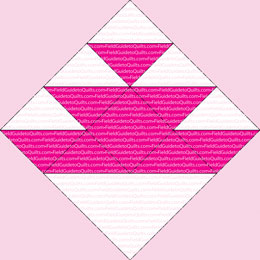| FieldGuidetoQuilts.com |
 Lady of the Lake & more Lady of the Lake & more
|
| Box: To Border, or Not to Border? |
Lady of the Lake
 Lady of the Lake: another traditional layout
Lady of the Lake: another traditional layout 
Lady of the Lake: another traditional layout
 Classic layout
Hills of Vermont
Classic layout
Hills of VermontFirst published in the Ladies Art Company catalog of 1897 as #174, the Lady of the Lake is a split block; the colors are reversed on either side of a diagonal line.
The name could be as old as the legend of King Arthur, but we think the block was more likely named for a book-length potboiler of a poem by Sir Walter Scott, published in 1810. Set in the Scottish Highlands, The Lady of the Lake swept Anglophiles off their feet, including American quilters.
The "lady" was a chieftan's daughter, Ellen. Whenever they had visitors, she'd row a boat from the island castle where they lived to the lakeshore to pick them up. Ellen was Scotland's most eligible bachelorette. One-sentence spoiler: Of the three gallant galoots who loved her, she got the one she wanted.
Scott's story had a long tail. It drenched Victorian literature in syrup and all but wrote Hollywood's quintessential script. Hail to the Chief, the Presidents' official anthem, is from an 1812 musical based on the story. It was first used by ex-President George Washington.
The name Hills of Vermont was designer Nancy Page's brainchild, ca. 1938.
The traditional, signature layout of Lady of the Lake is on point, meaning that the squares are turned 45 degrees. The large, dark half-triangles are at the bottom with the lighter ones on top. The layout suggests sky over water. The off-point layout is also traditional.
Framed Squares
















Framed Squares Waving Grain
A 1934 block by Nancy Page (Florence La Ganke) of the Birmingham News; the paper published it under the name Waving Grain in 1941.
Indian Plume
 Indian Plume
Indian Plume appeared around 1963 in an "Aunt Martha" booklet (#3614). The block's corners are clipped off to accommodate the whole-quilt design. A sawtooth border surrounded the multiblock pattern.
Indian Plume
Indian Plume appeared around 1963 in an "Aunt Martha" booklet (#3614). The block's corners are clipped off to accommodate the whole-quilt design. A sawtooth border surrounded the multiblock pattern. Indian Plumes
















Indian Plumes
 Indian Plumes
Indian PlumesHinson
1973
West Wind
 West Wind
The Victory Boat
West Wind
The Victory BoatCredited to Nancy Page (1934), this block also appeared in the Kansas City Star in 1944 with the timely name "Victory Boat."
The Star's version, sent in by a reader, had just two colors. The triangle in medium pink at left was the same dark color as the sawtooths.
Sail Boat
 Sail Boat
Sail BoatHall
1935
















Sail Boat Quilt researcher Carrie Hall published Sail Boat in her 1935 book The Romance of the Patchwork Quilt in America, and she included it and Sailboat, below, in the collection of blocks she stitched up and donated in 1938 to the Spencer Museum of Art at the University of Kansas.
Sailboat
 Sail Boat
Sail BoatHall
1935
















Sailboat
















Sailboat Quilt researcher Carrie Hall published Sail Boat in her 1935 book The Romance of the Patchwork Quilt in America, and she included it and Sailboat, below, in the collection of blocks she stitched up and donated in 1938 to the Spencer Museum of Art at the University of Kansas.
Birds in the Air
 Birds in the Air
Birds in the Air Birds in the Air
Birds in the AirHolstein
1973
.pdf of KCS block dated 5/9/31
Old Maid's Puzzle
















Old Maid's Puzzle
 Old Maid's Puzzle
Old Maid's PuzzlePrize Winning Designs
ca. 1931











